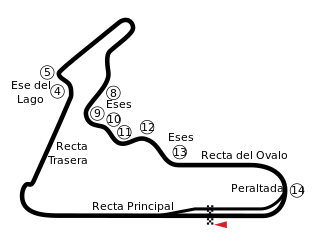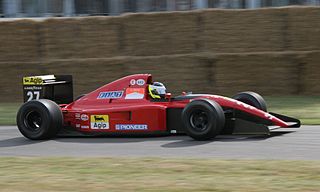Scuderia Ferrari S.p.A. is the racing division of luxury Italian auto manufacturer Ferrari and the racing team that competes in Formula One racing. The team is also known by the nickname "The Prancing Horse", in reference to their logo. It is the oldest surviving and most successful Formula One team, having competed in every world championship since the 1950 Formula One season. The team was founded by Enzo Ferrari, initially to race cars produced by Alfa Romeo. However, by 1947 Ferrari had begun building its own cars. Among its important achievements outside Formula One are winning the World Sportscar Championship, 24 Hours of Le Mans, 24 Hours of Spa, 24 Hours of Daytona, 12 Hours of Sebring, Bathurst 12 Hour, races for Grand tourer cars and racing on road courses of the Targa Florio, the Mille Miglia and the Carrera Panamericana. The team is also known for its passionate support base, known as the tifosi. The Italian Grand Prix at Monza is regarded as the team's home race.

The 1951 Italian Grand Prix was a Formula One motor race held on 16 September 1951 at Monza. It was race 7 of 8 in the 1951 World Championship of Drivers.

The 1952 French Grand Prix was a Formula Two race held on 6 July 1952 at Rouen-Les-Essarts. It was race 4 of 8 in the 1952 World Championship of Drivers, in which each Grand Prix was run to Formula Two rules rather than the Formula One regulations normally used. Unusually this race was run over a duration of 3 hours, rather than a fixed distance.

The 1952 Italian Grand Prix was a Formula Two race held on 7 September 1952 at Monza. It was the eighth and final round of the 1952 World Championship of Drivers, in which each Grand Prix was run to Formula Two rules rather than the Formula One regulations normally used. The 80-lap race was won by Ferrari driver Alberto Ascari after he started from pole position. José Froilán González finished second for the Maserati team and Ascari's teammate Luigi Villoresi came in third.

The 1959 French Grand Prix was a Formula One motor race held at Reims on 5 July 1959. It was race 4 of 9 in the 1959 World Championship of Drivers and race 3 of 8 in the 1959 International Cup for Formula One Manufacturers. It was the 37th French Grand Prix and the twelfth to be held at the Reims highway circuit and the fourth to be held on the longer and faster 8.348 km layout. The race was held over 50 laps of the eight kilometre circuit for a race distance of 417 kilometres.

The 1959 German Grand Prix was a Formula One motor race held at the Automobil-Verkehrs- und Übungs-Straße in West Berlin on 2 August 1959. It was race 6 of 9 in the 1959 World Championship of Drivers and race 5 of 8 in the 1959 International Cup for Formula One Manufacturers. It was the 21st German Grand Prix and was only the second time the race was not held at the Nürburgring. AVUS had previously held the original German Grand Prix in 1926. The race was held over two 30 lap heats of the eight kilometre circuit for a total race distance of 498 kilometres.

The 1960 Italian Grand Prix was a Formula One motor race held at Monza on 4 September 1960. It was race 9 of 10 in the 1960 World Championship of Drivers and race 8 of 9 in the 1960 International Cup for Formula One Manufacturers. The race was won by American driver Phil Hill driving a Ferrari 246 F1.

The 1966 Mexican Grand Prix was a Formula One motor race held at the Ciudad Deportiva Magdalena Mixhuca on 23 October 1966. It was race 9 of 9 in both the 1966 World Championship of Drivers and the 1966 International Cup for Formula One Manufacturers. The race was the fifth Mexican Grand Prix and the first to be run under the new three-litre Formula. It was held over 65 laps of the 5 km (3.1 mi) circuit for a race distance of 325 km (202 mi).

The 1979 Italian Grand Prix was a Formula One motor race held on 9 September 1979 at Monza. It was the thirteenth race of the 1979 World Championship of F1 Drivers and the 1979 International Cup for F1 Constructors.

The 1986 French Grand Prix was a Formula One motor race held at Paul Ricard on 6 July 1986. It was the eighth race of the 1986 Formula One World Championship.

The 1990 Portuguese Grand Prix was a Formula One motor race held on 23 September 1990 at Autódromo do Estoril. It was the thirteenth race of the 1990 FIA Formula One World Championship. The race was the 19th Portuguese Grand Prix and the seventh to be held at Estoril. It was scheduled to be held over 71 laps of the 4.35-kilometre (2.70 mi) circuit but was stopped after 61 laps, a race distance of 265.35 kilometres (164.88 mi), after an accident involving the Arrows of Alex Caffi and the Lola of Aguri Suzuki.
The 1991 Canadian Grand Prix was a Formula One motor race held at Circuit Gilles Villeneuve on 2 June 1991. It was the fifth race of the 1991 FIA Formula One World Championship.

The 1996 FIA Formula One World Championship was the 50th season of FIA Formula One motor racing. The championship commenced on 10 March and ended on 13 October after sixteen races. Two World Championship titles were awarded, one for Drivers and one for Constructors.

The Ferrari 643 was a Formula One car designed by Steve Nichols and Jean-Claude Migeot and was built by Scuderia Ferrari for use in the 1991 Formula One season. Built during May and introduced at the French Grand Prix it initially looked to have the potential to run at the front. Alain Prost qualified on the front row and took the lead, and although he was eventually passed by Nigel Mansell in his Renault powered Williams FW14, a second place in the car's first race looked promising. Aside from almost always being on the front part of the grid, it was not to be, however. The chassis of the 643 was a total redesign over the 642 which suffered inconsistent handling issues and was designed to allow for softer suspension travel, as per Prost's request. The V12 engine was upgraded six major times during 1991, with the final evolution used from Portugal to the end of the season. The chassis itself had two revisions, the first after the French Grand Prix—which saw a relocation of the exhaust exits from underneath the car, and Belgium which saw minor alterations to the body cover.

The Ferrari F93A was the Formula One racing car with which Scuderia Ferrari competed in the 1993 Formula One World Championship. Designed by Jean-Claude Migeot, the car carried the team's own 745 bhp V12 engine and ran on Goodyear tyres. It was driven by Frenchman Jean Alesi, in his third season with Ferrari, and Austrian veteran Gerhard Berger, who had returned to the team after three years at McLaren.

There have been 74 Formula One drivers from France, the most successful of them being Alain Prost who won the World Drivers' Championship four times.

The 2013 Brazilian Grand Prix was a Formula One motor race that was held at the Autódromo José Carlos Pace, in São Paulo, Brazil on 24 November 2013. The race marked the 42nd running of the Brazilian Grand Prix. The race was the nineteenth and final round of the 2013 Formula One World Championship. This was also the last race for the 2.4-litre V8 naturally-aspirated engines that were introduced at the 2006 Bahrain Grand Prix and the last race for naturally aspirated engines in general which had been mandatory since 1989. For 2014 Formula One introduced 1.6-litre V6 turbocharged power units with hybrid energy recovery systems.

The Scuderia Toro Rosso STR14 is a Formula One racing car designed and constructed by Scuderia Toro Rosso to compete in the 2019 FIA Formula One World Championship. The car made its debut at the 2019 Australian Grand Prix.

The Ferrari SF90 is a Formula One racing car designed and constructed by Scuderia Ferrari to compete during the 2019 Formula One World Championship. The chassis was designed by Mattia Binotto, Enrico Cardile, Fabio Montecchi and David Sanchez with Corrado Iotti leading the powertrain design. The car was driven by Sebastian Vettel and Charles Leclerc, who was making his debut for Scuderia Ferrari. The car made its competitive debut at the 2019 Australian Grand Prix.
This article gives a general overview of motorsport in Italy. For a more exhaustive view see; Motorsport in Italy by decade and Motorsport in Italy by year. Motorsport is widely popular in Italy, and its history spans over a century back to the early 1900s. Today, Italy is considered a hub of motorsport in terms of racing venues, drivers, teams, and manufacturers. It hosts annual races across Formula One, MotoGP, the World Touring Car Cup, and other prominent motor racing series.
















